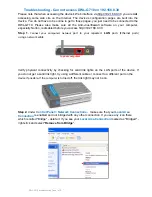
MN700004 Rev 01
186
15. GARP Multicast Registration
Protocol (GMRP)
Introduction
GARP Multicast Registration Protocol (GMRP) is a Generic Attribute Registration Protocol
(GARP) application that provides a constrained multicast flooding facility similar to IGMP
snooping. GMRP and GARP are industry-standard protocols defined by the IEEE 802.1p.
Feature Overview
GMRP can register and deregister multicast group addresses at the MAC layer throughout the
Layer 2 connected network. GMRP is Layer 3 protocol independent, which allows it to
support the multicast traffic of any Layer 3 protocol (such as IP, IPX etc.).
GMRP software components run both on the switch and on the host (The switch is not a
source for GMRP host software). On the host, GMRP is typically used with IGMP: the host
GMRP software generates Layer 2 GMRP versions of the host’s Layer 3 IGMP control
packets. The switch receives both the Layer 2 GMRP and the Layer 3 IGMP traffic from the
host. The switch uses the received GMRP traffic to constrain multicasts at Layer 2 in the
host’s VLAN.
NOTE
In all cases, you can use IGMP snooping to constrain multicasts at Layer 2 without the need
to install or configure software on hosts.
When a host wants to join an IP multicast group, it sends an IGMP join message, which
creates a corresponding GMRP join message. When the switch receives the GMRP join
message, it adds the port through which the join message was received to the appropriate
multicast group. The switch propagates the GMRP join message to all other hosts in the
VLAN, one of which is typically the multicast source.
When the source is multicasting to the group, the switch forwards the multicast only to the
ports from which it received join messages for the group.
The switch sends periodic GMRP queries. If a host wants to remain in a multicast group, it
responds to the query. In this case, the switch does nothing. If a host does not want to remain
in the multicast group, it can either send a leave message or not respond to the periodic
queries from the switch. If the switch receives a leave message or receives no response from
the host for the duration of the leave-all timer, the switch removes the host from the multicast
group.
















































